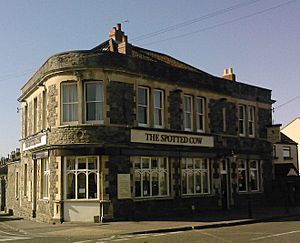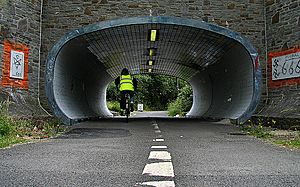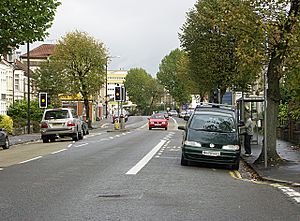Fishponds facts for kids
Quick facts for kids Fishponds |
|
|---|---|
| Population | 37,575 |
| OS grid reference | ST637758 |
| Unitary authority | |
| Ceremonial county | |
| Region | |
| Country | England |
| Sovereign state | United Kingdom |
| Post town | BRISTOL |
| Postcode district | BS16 |
| Dialling code | 0117 |
| Police | Avon and Somerset |
| Fire | Avon |
| Ambulance | Great Western |
| EU Parliament | South West England |
| UK Parliament |
|
Fishponds is a big neighborhood in the northeast of Bristol, England. It is about 3 miles (5 km) from the city center. Fishponds has two large parks from the Victorian era. These are Eastville Park and Vassall's Park, also known as Oldbury Court. The River Frome flows through both parks. You can walk along the Frome Valley Walkway next to the river.
Near Vassall's Park, you can find a restored mill at Snuff Mills. It still has its original waterwheel, which you can see and hear turning. Eastville Park has a large lake where people can go boating. This lake also has special areas for wildlife. Fishponds is mostly a place where people live. Its houses are often terraced homes from the Victorian times.
The main street in Fishponds has many shops. These include an international supermarket and Asian food stores. You can also find charity shops, takeaways, and big supermarkets like Lidl, Aldi, and Morrisons. Some students live here because the University of the West of England has a campus nearby.
The name Fishponds comes from its past. It used to be an area with many quarries. When these quarries were empty, they filled with water and became large fishponds. Most of these ponds have now been filled in. One pond, called "The Lido" by locals, was a popular swimming spot. It stayed open until the mid-1970s. Today, this pond is used by an angling (fishing) club.
Contents
What Can You Do in Fishponds?
Fishponds has many places to visit. There are 16 pubs, and most of them are very old. They were built during the Victorian era. Two pubs, the Old Post Office and the VanDyke, used to be something else. The VanDyke was a large movie theater that opened in 1926. It could hold 1200 people!
The Star pub, built in 1853, has a cool history. It was once the main meeting place for the Bristol Rovers football club. They were known as the Black Arabs back in the 1890s. Many of these pubs are located along Fishponds Road.
How to Get Around Fishponds
It's easy to travel in and out of Fishponds.
Buses in Fishponds
Most of Fishponds is served by First West of England buses. These include routes 48/48A/49, 17, Y2, and Y5. Other routes like 5, 6, and 7 serve the edges of the area.
Trains and Trams in Fishponds
The Fishponds railway station opened in 1866. It closed in 1965. This station had a special track for trains built by the Avonside Locomotive Works. These trains could join the main railway line here.
Today, the old railway line is a popular path for bikes and walkers. It is called the Bristol & Bath Railway Path. You can get onto this path from several spots in Fishponds.
Trams also used to run in Fishponds. The Bristol Tramway operated from Old Market to Fishponds from 1897 to 1941. Currently, Fishponds does not have its own train station. The closest stations are Stapleton Road and Filton Abbey Wood. There are plans to reopen two stations nearby, which will make train travel easier for people in Fishponds.
Local Government in Fishponds
Fishponds is part of the city and county of Bristol. Most of the area belongs to the Frome Vale council ward. Smaller parts are in the Hillfields ward and the Eastville ward.
Who Lives in Fishponds?
The areas around Fishponds include Chester Park and Mayfield Park. Fishponds is surrounded by five other neighborhoods: Downend, Staple Hill, St. George, Eastville, and Stapleton. In 2011, the total population of the greater Fishponds area was 37,575 people.
Here is a look at the different ethnic groups in Fishponds compared to all of Bristol in 2011:
| 2011 Ethnic Groups | Fishponds | Bristol |
|---|---|---|
| White British | 69.3% | 77.9% |
| Asian | 10.4% | 5.5% |
| Black | 8.8% | 6.0% |
The History of Fishponds
A long time ago, the Fishponds area was part of the Royal Forest of Kingswood. Over many years, the forest got smaller as people built more things. The area was first called "Newe Pooles" in 1610. By 1734, it was known as "Fish Ponds."
In the 1600s, Fishponds was a busy village. Many stone cottages were built for miners and quarry workers. They dug for coal and stone. The village grew around two pools that formed from old quarries. These pools were filled in by 1839. However, one fishpond, called The Lido, still exists today on Alcove Road.
In the mid-to-late 1800s, Fishponds became a big center for manufacturing. Many factories were built along Lodge Causeway and Filwood Road.
Factories and Industry in Fishponds
Fishponds was home to several metal factories, called foundries. One was George Adlam & Sons, started in the 1830s. Another was Parnall & Sons, which made weights, measures, and shop fittings. This company later helped fit out passenger rooms on famous ocean liners like the RMS Britannic in 1929 and the QE2 in the 1960s.
The railway came through Fishponds in 1835. It had a special track for locomotives (train engines) made by the Avonside Locomotive Works. These engines could join the main line here. Another company, Peckett and Sons, also built locomotives until 1961.
Sweet Treats and Cars
From 1894, Palmer Bros made biscuits and cakes at two locations in Fishponds Road. One factory is now part of the City Glass Company. Webers chocolates opened in 1914 and made chocolates for 50 years. During World War II, they even made parts for cannons alongside their chocolates!
The car industry arrived in Fishponds in 1906. Straker-Squire opened a large factory on Lodge Causeway. This factory made many early London Buses. By 1909, it supplied 70 percent of them! The company also made trucks and raced its car designs. It moved to London in 1919.
Aircraft Manufacturing
The aircraft industry came to Fishponds in 1914. Brazil Straker on Lodge Causeway started building Rolls-Royce aircraft engines for the RFC during World War I. Later, another company, Cosmos Engineering, bought the firm. They designed the Cosmos Mercury engine.
After some changes, the Bristol Aeroplane Company took over the site in 1920. Later, Parnall & Sons acquired the site. From 1941, they made parts for many RAF aircraft. This included wings for De Havilland Tiger Moths and fuselages (the main body of the plane) for Short Stirling bombers.
After the war, Parnall & Sons kept making aircraft parts until about 1960. Today, a company called Diamonite Aircraft Furnishings on Goodneston Road makes high-quality aircraft interiors. They even made one for the Russian President Vladimir Putin.
Pottery, Paper, and Printing
Pountney & Co moved to Fishponds in 1905. They opened a large pottery factory on Lodge Causeway. This factory made many types of ceramics, from everyday dishes to fancy items. These were sold all over the world. The factory closed in 1971 and was later torn down. Now, a business park stands there.
E. S. & A. Robinson opened a big cardboard-box factory in 1922. A part of their company, Robinson's Waxed Paper Co. Ltd, built a new factory across the road in 1929. During World War II, this company also made aircraft parts for the Bristol Aeroplane Company. The company eventually closed in 1996. Today, other companies use these sites.
Famous People from Fishponds
Many interesting people have connections to Fishponds:
- Hannah More (1745–1833) was a writer, helper of others, poet, and playwright.
- William Yalland (1889–1914) was an English cricketer who died in World War I.
- Gordon Welchman (1906–1985) was a mathematician. He played a very important role in breaking codes during World War II at Bletchley Park.
- Roy Evans (born 1930) is an actor who appeared on British TV for many years.
- David Smith (1934–2003) was a cricketer who played for England.
- Roger Greenaway OBE (born 1938) is a singer, songwriter, and record producer.
- Roger Cook (born 1940) is also a singer, songwriter, and record producer.





